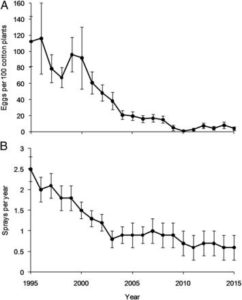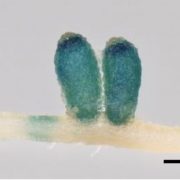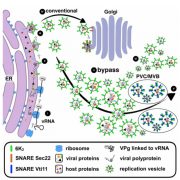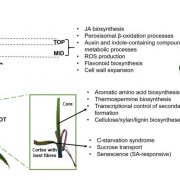Hybridizing transgenic Bt cotton with non-Bt cotton counters resistance in pink bollworm
 Biotic interactions are complex; any effort by the prey/host to defend against the predator/pathogen provides selective pressure towards overcoming those defenses. As new herbivore control methods are developed they quickly lose effectiveness as the pests evolve resistance; this is true whether the control method is sprayed externally or produced internally as it is in transgenic crops expressing Bacillus thuringiensis (Bt) protein. Wan et al. report on an 11-year study in China in which the cotton planted was the F2 generation from a cross between Bt plants and non-Bt plants (in the F2 generation 75% of the plants express the dominant Bt trait). The authors found that resistance to Bt in pink bollworm was substantially delayed, as the non-Bt plants provide a refuge for susceptible individuals. Because the insects were successfully controlled, insect population and insecticidal spray use both declined during this period. The authors propose that the hybridization-based strategy might be an effective alternative where refuge planting is impractical. Proc. Natl. Acad. Sci. USA 10.1073/pnas.1700396114
Biotic interactions are complex; any effort by the prey/host to defend against the predator/pathogen provides selective pressure towards overcoming those defenses. As new herbivore control methods are developed they quickly lose effectiveness as the pests evolve resistance; this is true whether the control method is sprayed externally or produced internally as it is in transgenic crops expressing Bacillus thuringiensis (Bt) protein. Wan et al. report on an 11-year study in China in which the cotton planted was the F2 generation from a cross between Bt plants and non-Bt plants (in the F2 generation 75% of the plants express the dominant Bt trait). The authors found that resistance to Bt in pink bollworm was substantially delayed, as the non-Bt plants provide a refuge for susceptible individuals. Because the insects were successfully controlled, insect population and insecticidal spray use both declined during this period. The authors propose that the hybridization-based strategy might be an effective alternative where refuge planting is impractical. Proc. Natl. Acad. Sci. USA 10.1073/pnas.1700396114










Leave a Reply
Want to join the discussion?Feel free to contribute!